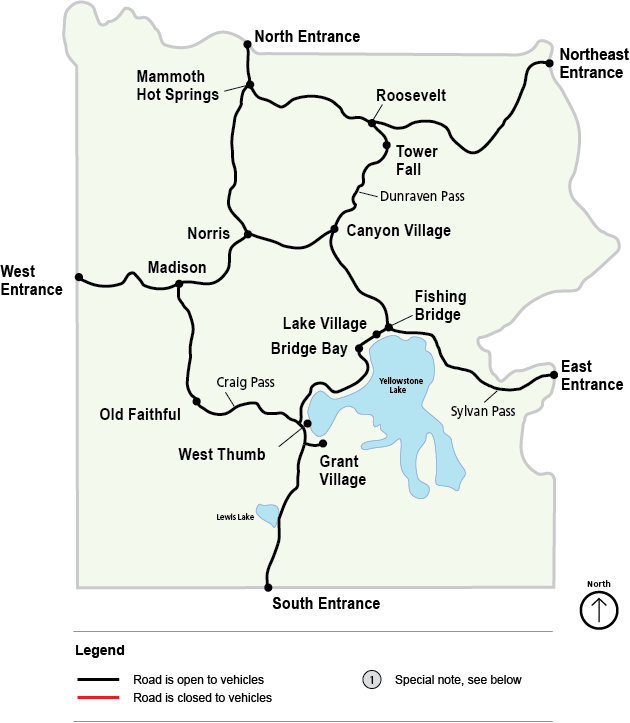I get a lot of comments and questions about my many photos from Yellowstone National Park (YNP) so I thought I would give a very quick overview of the park and some of its best known treasures.

Yellowstone is the world’s first national park dedicated to preserving the uniqueness of the natural beauty of our country for future generations. It was established as a model for all national parks in 1872 and its history has been colorful and controversial. Most of YNP lies withing the state of Wyoming but it extends into Montana and Idaho.
There are 5 major highway entrances to the park. The Grand Highway of Yellowstone is a giant figure of eight, paved highway connecting most of the park’s main attractions. Gardiner, MT is the north entrance to the park headquarters at Mammoth Hot Springs and is the only entrance that is open to automobiles year round. The northeast entrance is near Cooke City, MT and leads to Tower Falls on the north part of the figure eight. It is closed to autos in the winter months when the Bear Tooth highway is closed. Access to the east entrance is from Cody, WY to the Lake Village / Fishing Bridge area and this entrance is closed in the winter. The south entrance is one of the most popular routes into the park from Jackson, WY through Grand Teton National Park and the Rockefeller Parkway. The south entrance is closed to autos in the winter but Flag Ranch (near the south entrance) is a popular entrance for snow coach tours and snowmobiles. Finally, West Yellowstone, MT is a popular tourist town and center for winter activities near the west entrance to YNP. The road leads to Madison Junction and then south to Old Faithful or north to Norris Geyser Basin.
There are literally thousands of attractions to YNP but the “big five” are probably Old Faithful Geyser, the Grand Canyon of the Yellowstone, Mammoth Hot Springs, Lake Yellowstone, and the large animal populations of the Hayden and Lamar valleys. 

Old Faithful geyser, on the west side of the south loop, is one of more than ten thousand thermal features in the park that include geysers, fumaroles and steam vents, hot pools, and boiling mud pots. There are about four times as many active thermal features in Yellowstone as the rest of the world total. Old Faithful is named such because of its regularity of eruption – about every 70-90 minutes. Other geysers are larger and more spectacular but the predictability of Old Faithful and its closeness to parking and lodging make it a crowd favorite. The Grand Canyon of the Yellowstone River 

is at the east junction of the north and south loop roads. This is where Yellowstone got its name and is the home of the two largest waterfalls in the park. The canyon carved by the Yellowstone River is up to 1200 feet deep, three-quarters of a mile wide, and 24 miles long. The Upper Falls is 109 feet and the lower Falls is 308 feet in height and both are readily view-able with short walks from the many parking areas. 

Mammoth Hot Springs is near the park headquarters at the north entrance. Once the center for tourism with its terraced hot springs and colorful stone formations, the springs are seeing less water flow and becoming bleached white as their thermal activity decreases. Lake Yellowstone is the source of its namesake river and the largest and deepest lake above 7,000 feet altitude in North America. Its cold, deep, blue water has a shoreline of 110 miles and an average depth of 139 feet. 

Finally, while nearly all of YNP has abundant wildlife, nowhere are the large animals more visible than the great valleys of Lamar, near the northeast entrance, and Hayden, between Canyon and Lake Village. In these valleys are huge herds of bison numbering in the many hundreds, elk, mule and white-tail deer, pronghorn, black and grizzly bear, wolf, coyote, and many large bird species and small mammals. Roadside parking and the broad vistas make wildlife viewing as simple as picking up your binoculars.
I could go on for hours about all of the other attractions but remember the 310 miles of paved road (466 miles total) and 1,100 miles of developed trails from 92 trail heads access only a tiny fraction of the park’s 2.2 million acres. There is truly an unlimited amount of outdoor activity throughout Yellowstone. People ask, “How long should I plan to see the park?” The answer is as much time as you have but it takes at least 3 full days and two nights in or near the park just to drive to the major attractions. They also ask, “What month is best to visit?” All of the months are great and offer tremendously different views of the park. The north entrance is open to autos year round but the other entrances vary in opening from around late April to mid-May and start closing in October. Yellowstone is at high elevation, 6,500 to over 8,000 feet, and snow can and does come every month of the year. There is winter snowmobile and snow coach access from both the south and west entrances and great snowmobiling out of the park from the northeast entrance. There are over 3 million visitors annually with the vast majority coming in July and August. Locals will tell you that May and September are the “best” months because there are fewer visitors.
I hope you enjoy some of the photos of the park and that they will stimulate your interest in visiting this word treasure.


